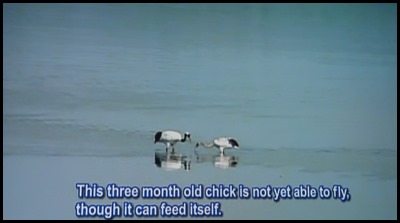Crane Day

|
Crane
Day
  The main reason for coming to Kushiro
was to try to see the Tancho or red-crowned crane. Never mind the pouring rain
or the threat of Typhoon Lan – we are made of stronger stuff. Bear settled us on
a bus after the bracing walk to the bus station. We have
a fifty-fifty chance of getting where we need to be. OK. We need the left fork going past the
airport. The look of muted
confidence.
 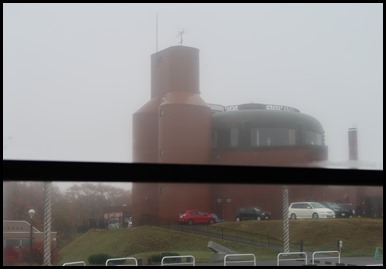 We crossed the
river as we left town, very high water. Three quarters of an hour later,
no passing of the airport, and a building shows through the rain – Oh, that’s the Kushiro Marsh
Observatory. Guess what ??? We are lost. Yep. Good, great, wonderful. It’s still tipping down
as we get off the bus and find ourselves at the corner of a field well known for
spotting a pair of crane – in the summer. Oh. We go over to read the sign anyway:
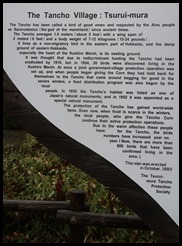 The Tancho Village: Tsurui-mura.
The Tancho has been called a bird of good omen and respected by the Ainu people
as Sarurunkamui (the god of the marshland) since ancient
times.
The Tancho averages 1.6 metres
(about 5 feet) with a wingspan of 2 metres (6 feet) and a body weight of 7-12
kilograms (15-24 pounds).
It lives as a non-migratory bird
in the eastern part of Hokkaido, and the damp ground of eastern Hokkaido,
especially the heart of the Kushiro Marsh, is its nesting ground.
It was thought that due to
indiscriminate hunting the Tancho had been eradicated by 1910, but in 1924, 20
birds were discovered living in the Kushiro Marsh. At once a joint
government-village protection operation was set up, and when people began giving
the corn they had held back for themselves to the Tancho that came around
begging for food in the severe winters, a food distribution program was also
begun by the local people. In 1935 the Tancho’s habitat was listed as one of
Japan’s natural monuments.
The protection of the Tancho has
gained world-wide fame. Even now, when food is scarce in the winters, the local
people, who give the Tancho corn continue their active protection operations.
Due to the warm affection these people
have for the Tancho, the birds numbers have increased year on year. (Now, there
are more than 600 birds that have been confirmed living in the area).
This sign was
erected in October 1993.
The Tsurui-mura
Tancho Protection Society.
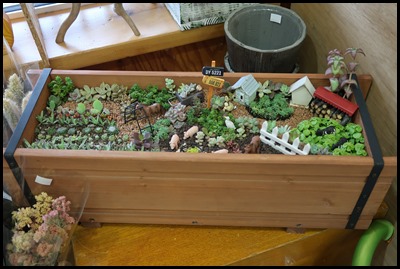 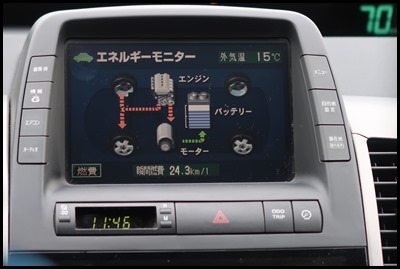 Opposite, we see a few shops and
enter a cafe. The nice owner cannot speak a word of English but when Bear shows
him where we should be on his phone, our new friend rings for a taxi – the only
ride we will do in Japan. We look about at the souvenirs, enjoy a miniature allotment in a wooden box, but when a
coach-load comes in for afternoon tea we wait outside. Our taxi arrives, pure
white lace seat covers. Our driver nods that he knows where we would like to go
and Bear was fascinated with the computer diagnostics
display on the centre console. I liked watching the wheels go around,
always reassuring.
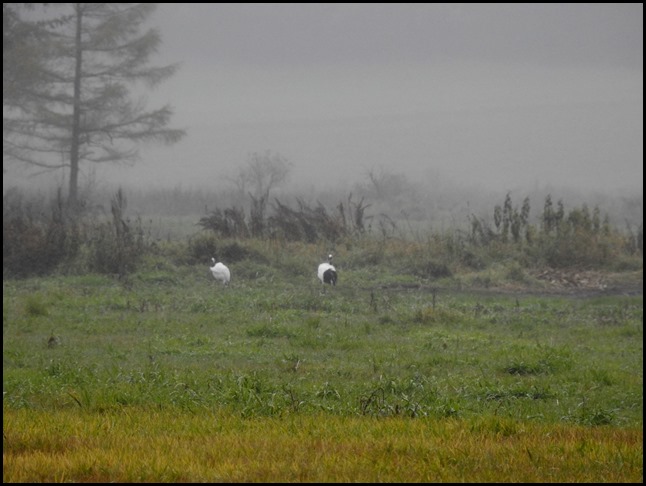 Well, colour me happy. We pass what
we think are two plastic bags on sticks, as in, poor-man’s-scarecrows, far away
to our left. Ten minutes later and we see another pair of white blobs.
Unmistakably, these are the very things we came to see. Our driver stops, I
crank the camera zoom as far as it will go and yes, a pair
of red-crowned cranes. Counting the first pair, as now convinced the
plastic bags were indeed our first cranes and.............
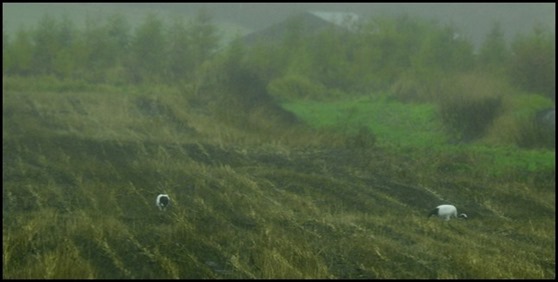 ................as our driver now
knows what it is we came to see, he stops the car once more. Far away to our
right, another pair.
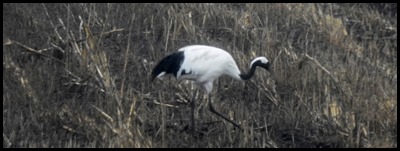 I zoom out to the never used maximum
2000 mm and use the car door for support, yes, there he is, the husband of the peace.
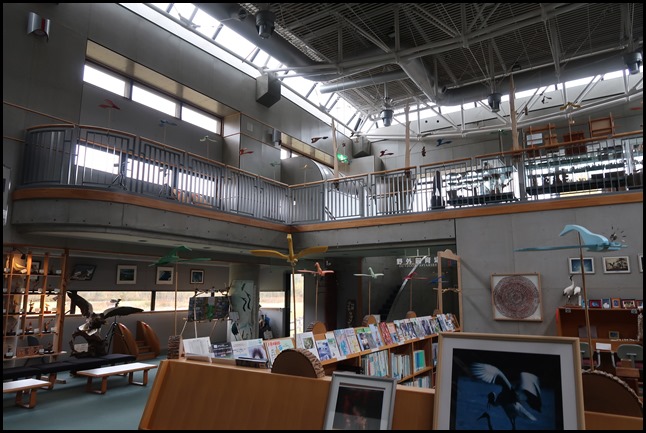 Thirty minutes later, we walk in to
the Akan International Crane Center. I excitedly tell
the lady on reception that we have seen three pairs and she wants hard proof. I
could tell as she fixed me with a piercing look from hooded eyes.........I flick
my camera into action and show her the screen. “Oh, yes. Lucky you, not many
people see them at this time of year, too early yet. They don’t come here until
late November”. Lucky indeed then. The lady tells us they have a pair and a
singleton out in the enclosures and a different sort. That will do us just fine.
On the leaflet the lady gave us, it now says there are about 1500 red-crowned
cranes, now that is a success story and heart-warming too.
  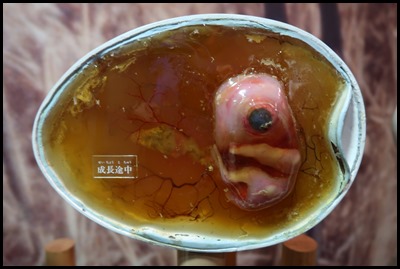 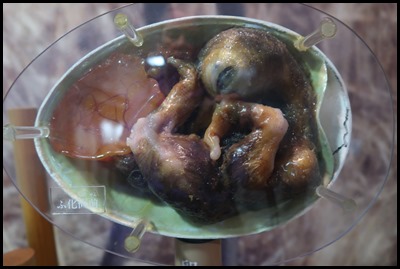 We head into the display area, first
trying the button to start a documentary about the local birds, that failed we
mince over a padded floor (meant to feel like walking in the marsh) and next to
the six-foot pretend next are four models of egg
development.
Over to Wiki: Breeding maturity is thought to be reached at 3-4 years of
age. All mating and egg-laying is largely restricted to April and early May. A
red-crowned crane pair duets in various situations, helping to establish
formation and maintenance of the pair bond, as well as territorial advertisement
and agonistic signalling. The pair moves rhythmically until they are standing
close, throwing their heads back and letting out a fluting call in unison, often
triggering other pairs to start duetting, as well. As it is occurring year
around, the social implications of dancing are complex in meaning. However,
dancing behaviour is generally thought to show excitement in the species. To
strengthen the bond, red-crowned cranes engage in dual honking rituals before
performing a dance.
Pairs are territorial during the breeding season. Nesting territories range from 1 to 7 km2 (0.39 to 2.70 sq mi) and are often the same year after year. Most nesting territories are characterized by flat terrain, access to wetland habitat, and tall grasses. Nest sites are selected by females, but built by both sexes and are frequently in a small clearing made by the cranes, either on wet ground or shallow water over waters no more than 20 to 50 cm (7.9 to 19.7 in) deep. Sometimes, nests are built on the frozen surface of water, as frigid temperatures may persist well into nesting season. Nest building takes about a week. A majority of nests contains two eggs, though one to three have been recorded. Both sexes incubate the eggs for at least 30 days. They also both feed the young when they hatch. Staying in the nest for the first few weeks, the young start to follow their parents as they forage in marshes by around 3 months of age. New hatchlings weigh about 150 g (5.3 oz) and are covered in yellow natal down for two weeks. By early fall, about 95 days after hatching, the young are fledged and are assured fliers by migration time. Although they can fly well, crane young remain together with their parents for around 9 months. Young cranes maintain a higher-pitched voiced that may serve to distinguish them from outwardly similar mature birds, this stage lasting until they leave parental care. The average adult lifespan is around 30 to 40 years, with some specimens living to 70 years of age in captivity. It is one of the longest-living species of bird.
We hear behind us that the film has
started, so we rush to sit down to watch a lovely documentary about the
red-crowned crane. Some very cute images and
thoughtfully placed subtitles.
 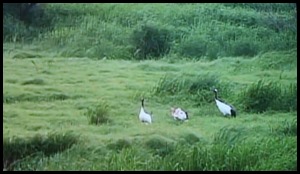 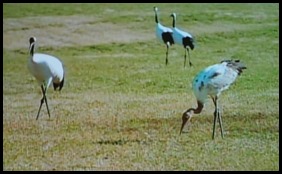 We watch a baby
flexing his wings, a family puttering about
and no animosity when a pair land
nearby.
 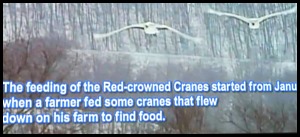  The red-crowned
cranes begin to flock here at the centre when the snow begins to fall,
deer, fox, rabbit and other birds come in for a free feed. A farmer began the
whole idea many years ago. Once a couple begin to
dance they start to shoo away last years baby, now quite capable of
looking after itself.
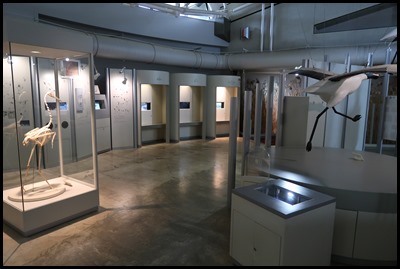 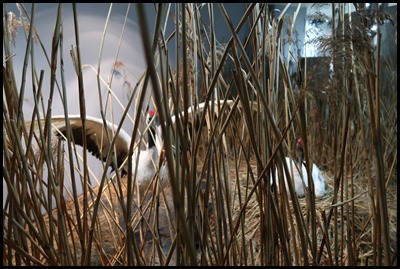 Film over, we bimble the rest of the exhibits. A huge model of what a nest would look like, with an animated, cross male
coming at you as you stand on the mat in front of the display.
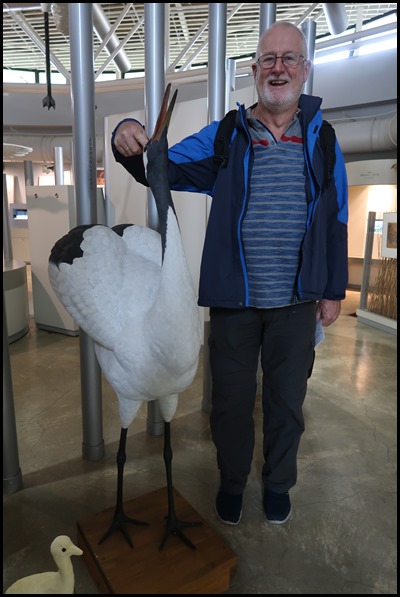 Of course the
trigger finger came out..........
 We found out which
cranes live where.
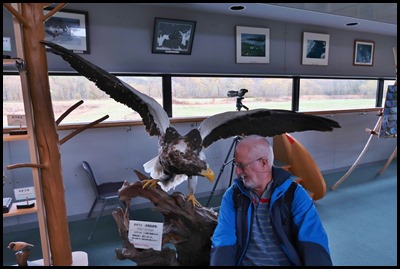 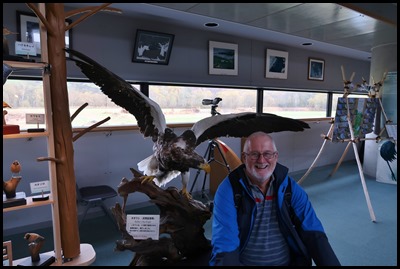 Bear poses with a stuffed Stellar’s sea eagle – shows how big they are.
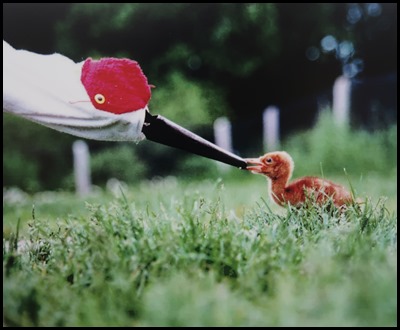 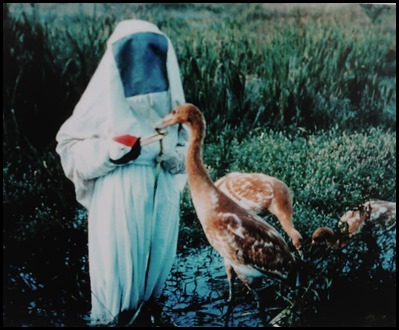 We love the surrogate parent feeding little ones who fail to thrive
with their parents.
 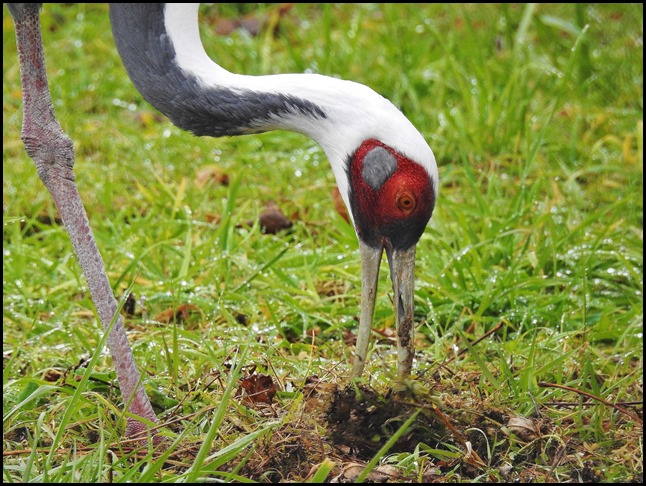 We head outside to the
enclosures and meet the white-naped crane scruffing about in
the wet grass.
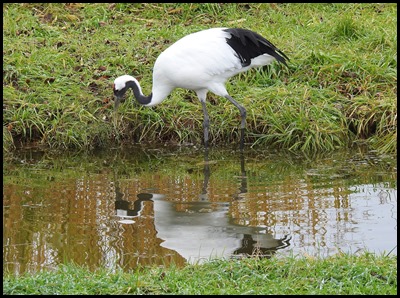 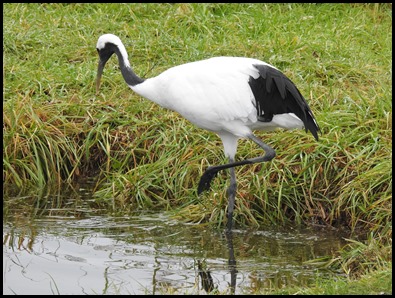 The single red-crowned crane was behind a wooden fence and made
for better pictures, as opposed to the pair who were frustratingly behind
mesh. Our chap loved his own reflection and we watch him preen every
single feather on his big body for about half an hour.
 Handsome was wonderful
to watch.
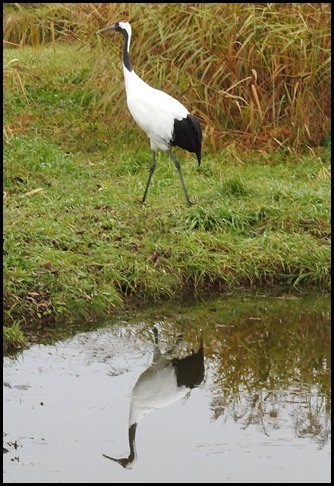 We left him strutting his stuff....................
 ................and returned to the white-naped crane, who had now taken up with the
preening.
 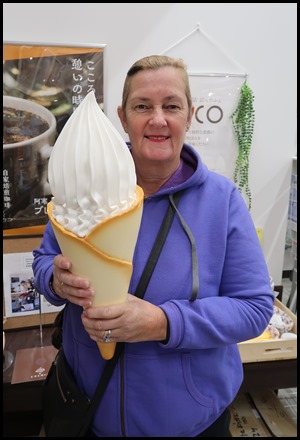  We bade our farewells to the lady at
reception, delighted to have spent time up closer to the cranes than in the
wild. We cross the road and pose in a souvenir shop with a model ice cream. Further on is a motel and we head there
for a very late set-meal lunch. Time for a real ice
cream sitting in the foyer as we wait for a bus to come at a quarter to
five.
 Safely back in our room, after seeing
countless umbrellas giving up the ghost. There is huge merit in wearing a good
anorak, plus the fact we spend all our time trying not to be blinded by
everyone’s weapon. We find the weather report. Things DO NOT bode well for take
off on the morrow as Typhoon Lan grows some huge
teeth.
ALL IN ALL CHUFFED TO HAVE
SEEN THEM
LUCKY TO GET LOST BECAUSE WE SAW THEM IN THE
WILD |

